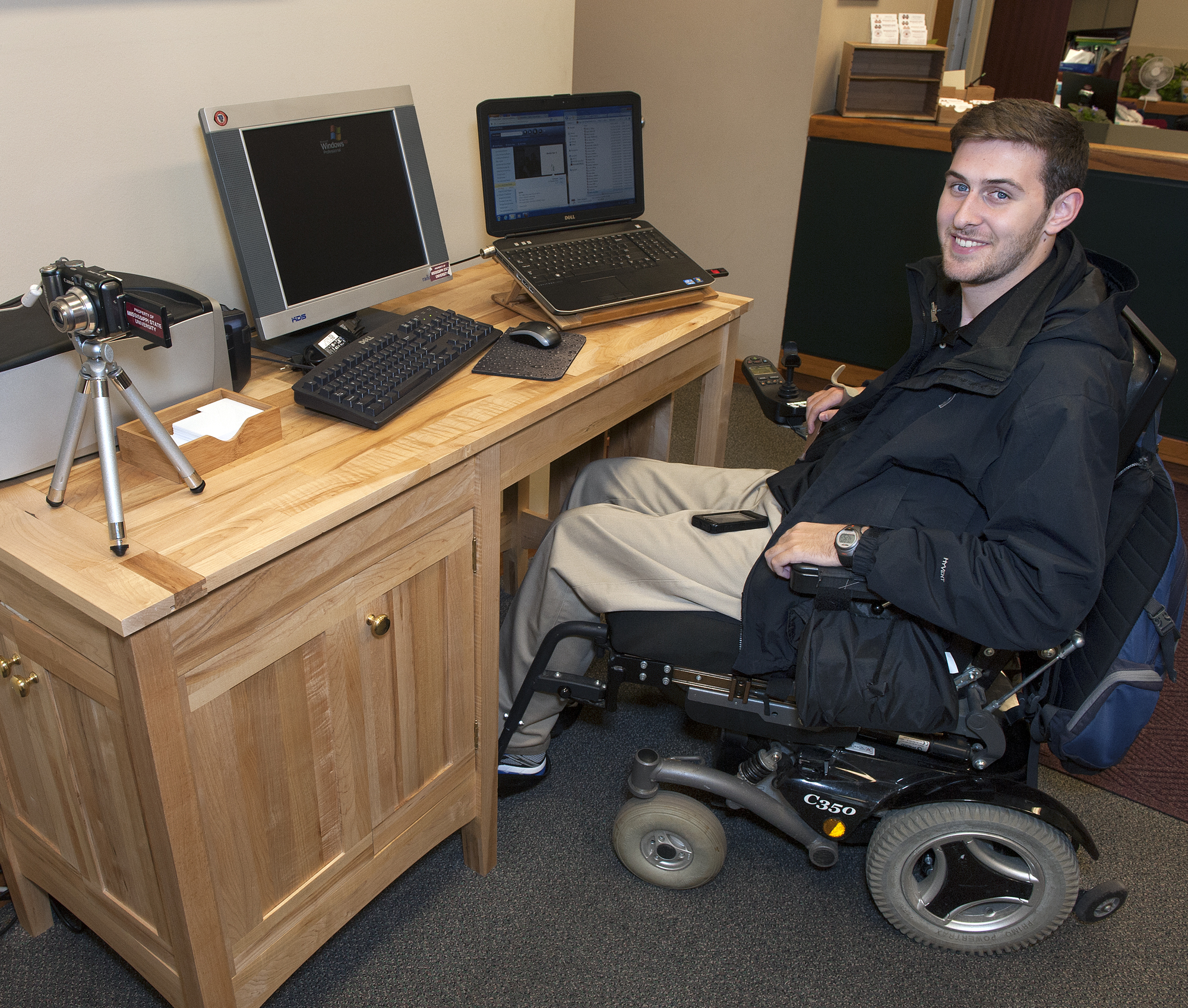Contact: Leah Barbour

Photo by: Beth Wynn
STARKVILLE, Miss.--When a partially disabled student worker at Mississippi State's Sanderson Recreation Center discovered his wheelchair didn't fit well at his work station, the university family came together to make a difference.
Junior history major Will Graves, of Soso, began working in the Sanderson Center in fall 2012. Office associate Jeannine Reed immediately recognized that Graves would benefit from a more user-friendly workspace. Despite his having to move from desk to desk to complete his responsibilities, Graves said a new desk would not be necessary.
"The desk I had in there -- I just made it work. I told her, 'I'm a chameleon. I just adapt and go with the flow,'" Graves said. "But they wanted to get me something that worked for me."
Reed said she was determined to make sure that Graves could access everything he needed to do his job from one central location.
"The welcome desk where he's also taking photo IDs--that location is where he needed to be," she said. "He's well spoken, so we knew he would be a good welcome-desk person. He talks to new members and tells what services we offer; he answers phones and he sorts and files. Will does all kinds of things."
Because of a chance flooding in one of Sanderson's studios, maple floorboards were already available for the project, said Patrik Nordin, associate director of recreational facilities. While staples and glue had to be removed so the wood could be resurfaced, the material was strong enough to make a desk that could last for years.
With the project conceptualized and the material readily available, the only thing Sanderson officials still needed was to recruit a person to design and build the desk. Reed knew just the right person for the task -- senior art major Morgan Welch of Madison.
MSU's recreational sports department already was collaborating on a few projects with the College of Architecture, Art and Design's advanced sculpture class, she said. Critz Campbell, associate professor of art, trained those students in furniture design, and Welch was one of the best, Reed thought.
She asked Nordin to approach Campbell and see if Welch would be willing to take on the project of designing an American Disabilities Act-compliant desk that would suit Graves' needs.
"I concurred that Morgan would be an excellent choice," Campbell said. "The project fit well into Morgan's objectives in my advanced sculpture class for that semester. This allowed me to provide support for Morgan's project in a class setting."
Welch began by reviewing ADA guidelines, but he knew he'd be using the same furniture-design techniques he had learned in Campbell's sculpture class.
"I build furniture pieces that are the last piece of furniture that you have to buy," Welch said. "I like putting an object into the world that has the potential to last hundreds of years -- something that will stand that test of time."
Because custom-made furniture should suit its user's needs, Welch also met with Graves to discover his vision of the perfect desk.
"Morgan told me what he was doing, and he sat down and asked, 'What do you need?' I said, 'Well, something that I can fit under and something that is up high enough for me to work because the main thing is leg room,'" Graves said. "He was sitting there sketching while I was talking, and he had it all drawn up by the time I was done."
Welch made a set of full-scale drawings before he began the process of removing the glue and staples from the boards. Then, he resurfaced individual boards until he collected enough wood for the desk. He updated his class throughout the semester on his progress and setbacks along the way.
Not only did Welch make an "A" on the project in his advanced sculpture class, Graves has been using the desk during the spring semester.
"As soon as I got here to State, I was already part of the family. That's one thing I've noticed about Sanderson: It's very welcoming. I have enjoyed my time here because the people have just welcomed me, the whole campus," Graves said. "They did all they could to give me what I needed to work with."
Nordin said the collaborative project was a win-win. Salvaged wood from a water-damaged studio was used to develop a student's furniture-design experience and create a special desk for a hard-working student.
To learn more about the university, visit www.msstate.edu.